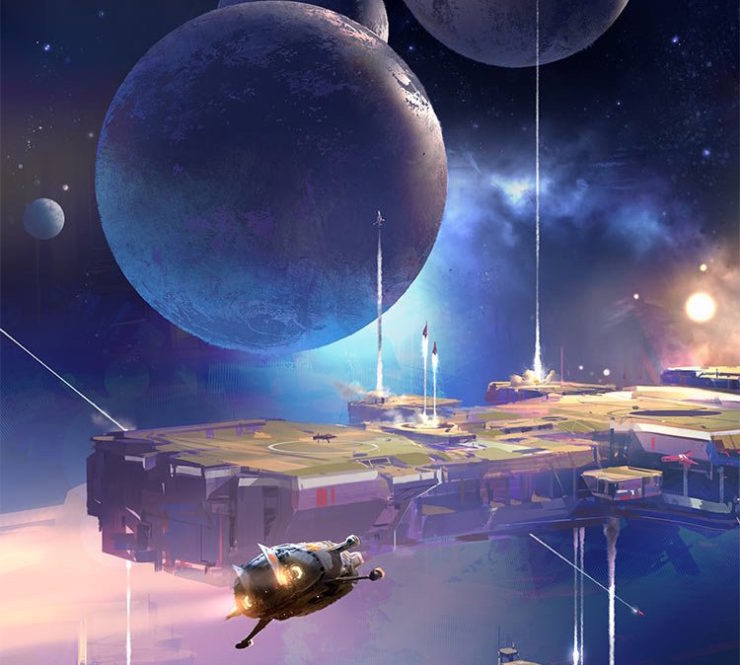As previously established, three-dimensional maps present increasingly intractable problems for two-dimensional media. SF authors who want to create a coherent map for their setting (even one they never plan to share with their readers) can make the task easier for themselves by using one simple strategy: instead of permitting travel between any two stars, they can restrict travel to a few systems. Authors need only keep track of the connections between systems, not the 3D relationships between the stars.
One way to achieve this is by placing limits on the space drive’s useful range. The roleplaying game 2300 AD provides an example: stutterwarp drives generate lethal radiation if used to cross distances longer than 7.7 light years. While 2300 AD did, as explained in my previous article, provide a 3D map of near space, it was more relevant to know what stars (or massive bodies that could discharge the drive) were within 7.7 light years of each other. Similarly, while the venerable SF movie Forbidden Planet focused on a single system and so didn’t need to provide a map, the fact that starships could only hit 16 C implies that humans only had routine access to a small, easily charted region of space.
Then there’s the ever-popular “we found these abandoned transit stations” scenario. If humans aren’t the builders of the system, they probably don’t know how to expand it or change it. Because Ancients are notorious for their failure to properly document their networks, humans and other newcomers have to explore to see where the wormholes/tunnels/whatever go. Explorers are like rats wandering through an abandoned subway system. Examples:
- the Tipler Cylinder system in Poul Anderson’s Avatar;
- the alien network in Glen Cook’s lamentably obscure The Dragon Never Sleeps;
- the interstellar portal system in Simak’s Shakespeare’s Planet;
and many more.
A variation upon this trope is “we punched some buttons and the ancient spaceship took us where it was programmed to go.” The explorers in Andre Norton’s Galactic Derelict, for example, can only travel to the destinations on their appropriated starship’s navigation tapes.
A third, and quite popular, alternative involves natural shortcuts in space time over which the travellers have little control. In novels like Haldeman’s The Forever War, Paul Preuss’ The Gates of Heaven, and Vinge’s The Snow Queen, faster than light travel is dependent on black holes. Systems not adjacent to a black hole system are inaccessible. In settings like Niven and Pournelle’s The Mote in God’s Eye, McCollum’s Antares trilogy, and Bujold’s Vorkosigan books, tramlines and jump points exist under specific conditions and provide access to only a handful of nearby systems. The Antares and Vorkosigan books, as well as McIntyre’s Starfarers series, add the extra twist that routes may change over time; systems once accessible may be cut off and systems previously unknown may suddenly become easily reachable, just a jump away. See also: Scalzi’s Interdependency trilogy-in-progress.
Bob Shaw’s Nightwalk threw in an interesting twist with non-commutative hyperspace. This means that AB does not equal BA. Finding one’s way to a life-bearing world via a myriad of blind jumps is only half the mission. Getting home to Earth for the first time requires finding the proper sequence of jumps—how many, nobody knows. The short-term solution was to send out a billion robot probes, of which only one found its way to a useful world and back.
Even if the means to bridge vast distances is within explorer control, the cost of artificial wormholes and the time involved in getting one end of the wormhole to potential destinations may force the explorers to choose very carefully between candidate systems. In Lumpkin’s Human Reach series, humans can only reach stars to which their wormhole-equipped probes have been dispatched. In Poul Anderson’s The Enemy Stars, explorers have visited only a minute fraction of the systems in the Milky Way—despite centuries of effort.
Niven’s “All the Bridges Rusting” provides another variation on the theme. As with the Lumpkin and the Anderson, transmission is only possible to systems to which receiver-equipped sublight probes have been sent (at the time of the story, this means only Alpha Centauri). Niven doesn’t even give his characters the benefit of instant teleportation: travel from booth to booth is at the speed of light. Jumping from Sol to Alpha Centauri not only meant losing more than four years in transit, but required an act of faith that the receiver would still be working by the time one got to one’s destination.
Each of these ploys (and perhaps some I haven’t listed—suggestions welcome in the comments) limit the scale of the setting to something humans can understand. They also shape the plots in entertaining ways. Limits are often seen as affronts to creative potential, but when it comes to telling stories (or writing villanelles), they can be useful tools.
In the words of Wikipedia editor TexasAndroid, prolific book reviewer and perennial Darwin Award nominee James Davis Nicoll is of “questionable notability.” His work has appeared in Publishers Weekly and Romantic Times as well as on his own websites, James Nicoll Reviews and Young People Read Old SFF (where he is assisted by editor Karen Lofstrom and web person Adrienne L. Travis). He is surprisingly flammable.










